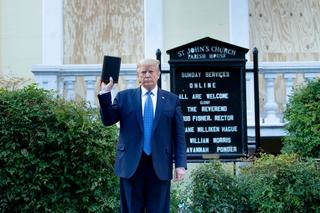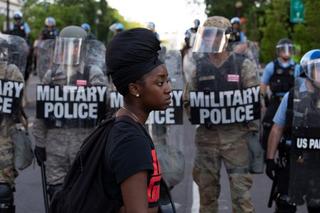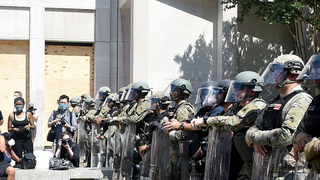Footage from a 1 June assault on Channel Seven reporter Amelia Brace and cameraman Tim Myers in Washington, DC exposed Australians first-hand to the widespread and ongoing police brutality in the spotlight in the United States following the killing of George Floyd. Just blocks away from the site of the journalist assault, local police used tear gas on peaceful protesters to allow President Trump to stage a photo op in front of a local church. He also directed active-duty Army units to report to Washington and threatened to invoke the Insurrection Act, a law that could allow him to employ these units on domestic soil.
By 10 June, the number of National Guard soldiers activated to combat COVID-19 and help quell the protests reached more than 75,000 in total across the United States. Some reports suggest President Trump had wanted at least 10,000 active-duty troops to pour into the capital as a show of force. Earlier on 1 June, Secretary of Defense Mark Esper told state governors they should use National Guard soldiers to “dominate the battlespace” and the nation’s top general, Chairman of the Joint Chiefs Mark Milley, strode through the streets of Washington at night in his combat uniform “observing the situation” shortly after he had followed Trump to the church. Milley quickly attempted to distance himself from this controversy. Finally, on 11 June, Milley issued an astounding apology, stating, “I should not have been there. My presence in that moment and in that environment created a perception of the military involved in domestic politics.”

Still, the events of 1 June caused grave concerns among many in Washington. In response to President Trump’s threats and Milley’s high-profile involvement in the administration’s public relations approach, former Secretary of Defense and retired general Jim Mattis as well as a number of other retired senior generals broke with American tradition and publicly voiced their concerns about both President Trump’s leadership and the wisdom of using the military on domestic soil. In the face of these criticisms, President Trump appears to have at least partially backed down. His rhetoric has become less incendiary and the odds that he will use the military on domestic soil have decreased.
Subsequent protests have been more peaceful, de-escalating the current situation. Nevertheless, broader challenges facing the United States in terms of race, police brutality and the potential use of force for domestic purposes remain unresolved. With no political solution to these problems on the table, the potential for inadvertent escalation remains. To help understand the military’s role in the social and political crisis engulfing the United States watch for these four key indicators.
What forces are currently being used and under whose authority?
In early June, a patchwork of nearly 800,000 law enforcement officers from city, local, and state police departments and agencies comprised the overwhelming majority of the forces responding to the protests around the United States. The performance of these forces has varied wildly. In some cities, police have escalated the violence, such as when Kentucky police killed a protestor in Louisville on 1 June. In others, law enforcement officers have expressed horror and solidarity over Floyd’s death or marched alongside and danced with the protestors; and in still others police have stood down as looters rioted and committed acts of vandalism and theft.
Governors from 32 states have also called up members of the National Guard under state authority, with total domestic mobilisations now exceeding 75,000 personnel. Roughly half these troops are assigned to support the response to civil unrest under state authority. Decisions to call up the National Guard under state authority are guided by individual state laws that lay out specific rules for how the National Guard may be used. In almost all cases, however, governors have broad discretion to use these troops as they see fit. When states call up the National Guard, the costs are covered from by the state budget and the troops remain under the governor’s command. While under state control, members of the National Guard face no federal restrictions in their ability to conduct law enforcement tasks. Local restrictions vary by state, with some requiring governors to obtain legislative approval before using the Guard or placing minor restrictions on how these forces can be used. In almost all cases, however, governors can direct members of the National Guard to act as police forces, carrying out tasks such as curfew enforcement or riot control.
Another 38,000 troops continue to support state relief efforts for COVID-19. Trump has mobilised these troops using Title 32 of the United States Code, which leaves National Guard personnel under the direction of state governors while allowing the federal government to cover the costs. So far, however, Trump has not invoked this authority for the protest response and no governors have requested federal assistance.
The performance of these forces has varied wildly. In some cities, police have escalated the violence [...] In others, law enforcement officers have expressed horror and solidarity over Floyd’s death or marched alongside and danced with the protestors.
The one place where the National Guard falls under federal control is in Washington, DC. Because of the capital’s unique status, the president always serves as Commander in Chief of the district’s National Guard. In practice, however, this responsibility to direct the National Guard falls to the civilian Secretary of the Army – though reports suggest Trump has made known his preferences about how to manage the situation in Washington, DC. At the request of the federal government, almost a dozen other states have also voluntarily provided National Guard personnel to augment the DC National Guard, bringing the total number of troops in the capital to nearly 17,000. These personnel augment an array of law enforcement organisations, including district police, federal police, park police, and secret service. This decision has sparked a legal controversy, with several Constitutional scholars – and the mayor of Washington, DC – arguing that the president does not have the authority to take these actions. Nevertheless, now that these forces have now departed the capital, the courts would be unlikely to hear a case on this issue.
Plans for the use of National Guard and military personnel in Washington, DC have so far been contentious. During a 1 June “show of force” mission, two twin-engine Army National Guard helicopters hovered low above crowds of protestors on the city’s streets, blasting groups with fuel exhaust, air and debris. The Washington DC National Guard has now opened an internal investigation into why these helicopters flew at inappropriately low levels while failing to adhere to safety standards. Additional reporting suggests that at least some personnel from the DC National Guard have regrets about the role they played in response to the protests.
The introduction of out-of-state guard personnel has also been a point of friction between Washington, DC mayor, Muriel Bowser, and the federal government. As of 7 June, however, Trump had agreed to allow all out of state guard personnel to depart the capital. Nevertheless, he also has ordered approximately 1,600 active-duty troops to the national capital region from Fort Drum in New York and Fort Bragg in North Carolina. So far, they remain positioned outside the city.
Can the president use the military for domestic purposes, and will he?

Throughout US history, presidents have called on both the National Guard and active-duty military for domestic purposes, including for law enforcement, but their ability to do so remains subject to certain legal restrictions. The Posse Comitatus Act was passed in 1878 as part of a compromise to remove federal troops that had been occupying Confederate states to enforce black enfranchisement and land rights in the decade following the Civil War. Today, Posse Comitatus is the primary law constraining the use of federal troops for law enforcement. It prohibits the use of federal forces for police functions unless otherwise authorised by law. President Trump threatened to use one such law, known as the Insurrection Act, on 1 June.
Congress passed the Insurrection Act in 1807 as an update to an earlier law to strengthen the power of the president to call forth state militias in response to local rebellions and insurrections that challenged the ability of the young nation to impose federal law in outlying areas and along the frontier. The act was updated in 1871, just after the Civil War, to authorise the federal government to use the act to enforce the Equal Protection Clause of the Fourteenth Amendment to the US Constitution, which extended additional protections to emancipated slaves.
Throughout US history, presidents have called on both the National Guard and active duty military for domestic purposes, including for law enforcement, but their ability to do so remains subject to certain legal restrictions.
Constitutional scholars agree this law grants the president broad authority to federalise the National Guard or call on active-duty troops for domestic law enforcement. Trump’s ability to do so would be strongest if a state governor were to request federal support, as California Governor Pete Wilson did in 1992 – the last time the law was invoked – in response to the Los Angeles riots. These riots exploded after the police officers involved in the arrest and assault of Rodney King were acquitted, and Wilson asked President George HW Bush to send federal assistance when he deemed that the California National Guard did not have the capacity to get the situation under control. Historically, however, governors have been hesitant to request federal troops. In the wake of Hurricane Katrina in 2005, for example, Louisiana Governor Kathleen Blanco insisted that the Louisiana National Guard would remain under the direction of state authority. At least so far, it seems unlikely any state governor will request such support from Trump to address the current situation.
Even absent a state request, or perhaps even in the face of a state challenge, two other broad provisions of the Insurrection Act allow the president to direct federal troops to quell protests, leaving opponents with few legal remedies to challenge his decision. Although military units typically cannot participate in searches or seizures or arrest American citizens, normal restrictions do not apply if the president “lawfully orders them to enforce law, aid civil authorities, or suppress an insurrection.” If the president orders active-duty troops to do so, they can be used on domestic soil in ways that are indistinguishable from police officers.
If the military is used for domestic purposes, what laws will troops adhere to?
When a president orders troops to conduct law enforcement tasks, the federal government bears full responsibility for their actions. Any service member – whether active duty or National Guard – under the president’s command is funded by the federal government and falls under the Uniform Code of Military Justice (UCMJ) for discipline and accountability. While most service members are highly disciplined, President Trump’s willingness to grant clemency to two convicted war criminals and one alleged murderer last year introduces at least some uncertainty about whether any individual soldiers would feel less bound by legal constraints.
The military also would likely use the standing rules for the use of force (SRUF), a set of guidelines that dictate when and how they can use force while conducting policing tasks, just as members of the National Guard have used so far. The SRUF are highly restrictive and typically only authorise the use of deadly force in self-defense or when defending designated infrastructure or personnel from attack, and in most cases, service members do not carry loaded weapons if they carry weapons at all. Military units typically train and conduct military operations using more permissive rules of engagement, however, so they may be less prepared to conduct policing functions or de-escalate difficult situations. Given the troubling levels of police brutality and lack of accountability witnessed in the United States, many analysts believe active-duty troops may show more restraint.
Any service member – whether active duty or National Guard – under the president’s command is funded by the federal government and falls under the Uniform Code of Military Justice for discipline and accountability.
Even an aggressive mistake or inadvertent escalation by one soldier who is untrained and unprepared for a difficult situation could nevertheless cause a crisis. In 1970, members of the Ohio National Guard shot 13 unarmed students – killing four and wounding nine – who were participating in an anti-war gathering at Kent State University. Since the National Guard personnel were operating under state control, they were prosecuted under state law. After an initial conviction was overturned on appeal, the case was settled in civil court and no service members were ultimately convicted. Prosecutions of federal troops under the UCMJ are largely unprecedented in the modern era as well, in part because they have been used so infrequently.
Although a court has never overruled a president’s authority to invoke the Insurrection Act without state consent, the extent of his powers under the law remains subject to debate. A 2007 national defense act surreptitiously amended the Insurrection Act to explicitly grant the president authority to intervene in a state without state approval. After all fifty state governors sent a letter objecting to this change, the law quickly returned to its prior form. As currently written, the law neither explicitly requires a state request nor does it prohibit a president from using force against the objection of a state governor. University of Texas legal scholar Steve Vladeck has explained that the courts have historically interpreted these provisions of the Insurrection Act very broadly, however, granting the president wide latitude to determine when the provisions of the law apply as long as he first issues a “proclamation to disperse.” If protestors failed to heed this order, the President could then lawfully direct the military to operate on domestic soil and grant them powers that would be virtually indistinguishable from those of police officers. Unless Congress passes new legislation, Trump likely could invoke the Insurrection Act and take these steps with little practical opposition outside of public or political criticism.
As currently written, the law neither explicitly requires a state request nor does it prohibit a president from using force against the objection of a state governor.
Presidents have, in fact, ordered active-duty troops to conduct police tasks in the past, in some cases even over the objection of state governors. Presidents frequently relied on this provision to enforce civil rights legislation and end school segregation in southern states. President Dwight Eisenhower deployed active-duty troops and federalised the Arkansas National Guard to desegregate Central High School in Little Rock, Arkansas in 1957 against the wishes of the state’s governor. John Kennedy also used the Insurrection Act to enforce civil rights laws in Mississippi and to deploy federal troops to Birmingham, Alabama during civil rights protests in 1963 – each time without a request from the governor. In both cases, however, Kennedy publicly urged calm, reiterated the importance of non-violence and public order, and signaled his steps in advance, which helped to defuse the situation and pre-empted legal challenges from the states.
Although 28 years have passed since a president last used the Insurrection Act, Trump clearly is not alone in US history in suggesting he has the authority to use federal troops to quell protests. Where he has differed most from previous presidents, however, is in the belligerent tone used to brazenly signal he would use the military against American citizens to “dominate” US cities. During Trump’s nationally-televised speech on 1 June, he asserted that those engaged in looting, arson, or vandalism were engaged in “acts of domestic terror.” Trump also issued a blanket threat stating, “if a city or state refuses to take the actions necessary to defend the life and property of their residents, then I will deploy the United States military and quickly solve the problem for them.” He has since followed up with specific threats to use federal troops in Minnesota, New York, and Washington, DC.
Although 28 years have passed since a president last used the Insurrection Act, Trump clearly is not alone in US history in suggesting he has the authority to use federal troops to quell protests.
After a recording of Secretary of Defense Mark Esper urging state governors to use their National Guard units to rapidly “dominate the battlespace” leaked to the media, messaging from the Pentagon has become more measured. During a 3 June press conference, Esper indicated he did not support invoking the Insurrection Act to use the US military to manage protests across the United States, except as a last resort. A chorus of retired generals also broke their traditional silence to chastise Trump, both for suggesting he might invoke the act and for portraying American citizens as enemies. Thus, although President Trump retains the authority to use the military if protests spiral out of control or become more violent, it looks increasingly unlikely that any state will request support or that Trump will attempt to overrule them.
What impacts will this crisis have on the relationship between the military and American society?
Since the 1991 Gulf War, the United States military has been the most respected national institution in American society, with 73 per cent of Americans expressing confidence in the institution in 2019. Although active-duty units have not been – and remain unlikely to be – involved in the response to domestic protests, Trump’s rhetoric and the events of 1 June put the military center stage. As the protests continue, three factors are likely to shape how the relationship between American society and its military changes: (1) polarisation; (2) politicisation; and (3) presidential politics.

Despite high levels of overall support for the military, confidence in the institution is already somewhat polarised with 91 per cent of Republicans expressing “a great deal” or “quite a lot” of confidence in the military in 2019, compared to only 70 per cent of Democrats. As my own research with Peter Feaver shows, however, perceptions that the military is aligned with your political opponent do more damage to partisans’ confidence than perceptions that the military is on your side. With National Guard troops deployed largely in cities and urban areas that skew Democratic, younger, and more diverse, perceptions that the military is opposed to protestors have the potential to increase. So far, evidence suggests that the National Guard has been relatively restrained in most locations, but increasing militarisation of local police forces makes it harder for average Americans to distinguish between the police and the National Guard. And since National Guard soldiers wear regular Army uniforms, it is unlikely many Americans will make meaningful distinctions between these reserve forces and active duty. Intimidating uses of military force, such as the 1 June helicopter dust-off in Washington, may further exacerbate tensions. As a result, attitudes about the military seem poised to politicise even further, especially as polarised media coverage provides very different frames of military and police involvement. The most high-profile poll measuring public confidence in American institutions, conducted each summer by Gallup, is expected to be released sometime in July. That poll will be the first chance to gauge how recent events have shaped partisans’ attitudes about the military.
There is a long history of embattled US political leaders attempting to use the military’s high public esteem for political gains.
Additionally, pressures to politicise the military are likely to remain and possibly even increase. There is a long history of embattled US political leaders attempting to use the military’s high public esteem for political gains – such as when George W Bush put General David Petraeus front and center to sell the Iraq troop surge in 2007 or when Bill Clinton made General John Shalikashvili the face of NATO’s mid-1990’s intervention in Bosnia. Last week, President Trump’s decision to ask his top general – Chairman of the Joint Chiefs of Staff Mark Milley – to follow him across Lafayette Square shortly after protestors were cleared from the area with tear gas again put the US military in the political spotlight. Milley’s willingness to go along with Trump’s political stunt stands in stark contrast to Australian Defence Chief Angus Campbell’s actions during a press conference on 28 March, 2019. Rather than remaining on stage in uniform, Campbell deftly intervened when journalists’ questions for Defence Minister Christopher Pyne turned from questions about Australia’s leadership changes to a domestic political controversy. Although Milley later tried to distance himself from the photo op and took the bold step of issuing an apology he surely knew would become public, research suggests the damage to his own reputation – and potentially to the non-partisan tradition of the US military – may have already been done. Now, the chair of the House Armed Services Committee has asked Milley to testify before Congress about the military’s role in events last week and about military plans for potential involvement if the situation escalates. Despite Milley’s apology, the general and Secretary of Defense Mark Esper have so far both refused to testify, potentially reinforcing a growing public perception that the active-duty military is siding with Trump over Democrats in Congress. There is no clear precedent that would allow Pentagon leaders to refuse to testify, though previous occupants of these posts have sometimes negotiated the timing or terms of their appearances in the past.
Finally, presidential politics are also likely to draw the military further into the political arena, especially if the protests increase in salience. In response to Trump’s rhetoric and Milley’s participation in the photo op, an unprecedented number of retired generals and admirals – including former Secretary of Defense Jim Mattis and former Chairmen of the Joint Chiefs Colin Powell, Richard Myers, Michael Mullen, and Martin Dempsey – broke their traditional political silence to criticise Trump’s handling of the situation and political leadership. Although statements by these retired officers and Milley’s apology to some degree counteract prior actions, President Trump nevertheless will attempt to marshal military support of his own. Since these types of statements often don’t register with average Americans and polarised media presents very different versions of events, interventions by retired military officers often are not as influential as assumed, but they do provide candidates a type of insurance against attacks on their national security credentials. Nevertheless, many scholars of American civil-military relations worry that large-scale political involvement by even retired military officers could undermine American democratic traditions by causing citizens to look to the military as the final arbiter of political legitimacy.






